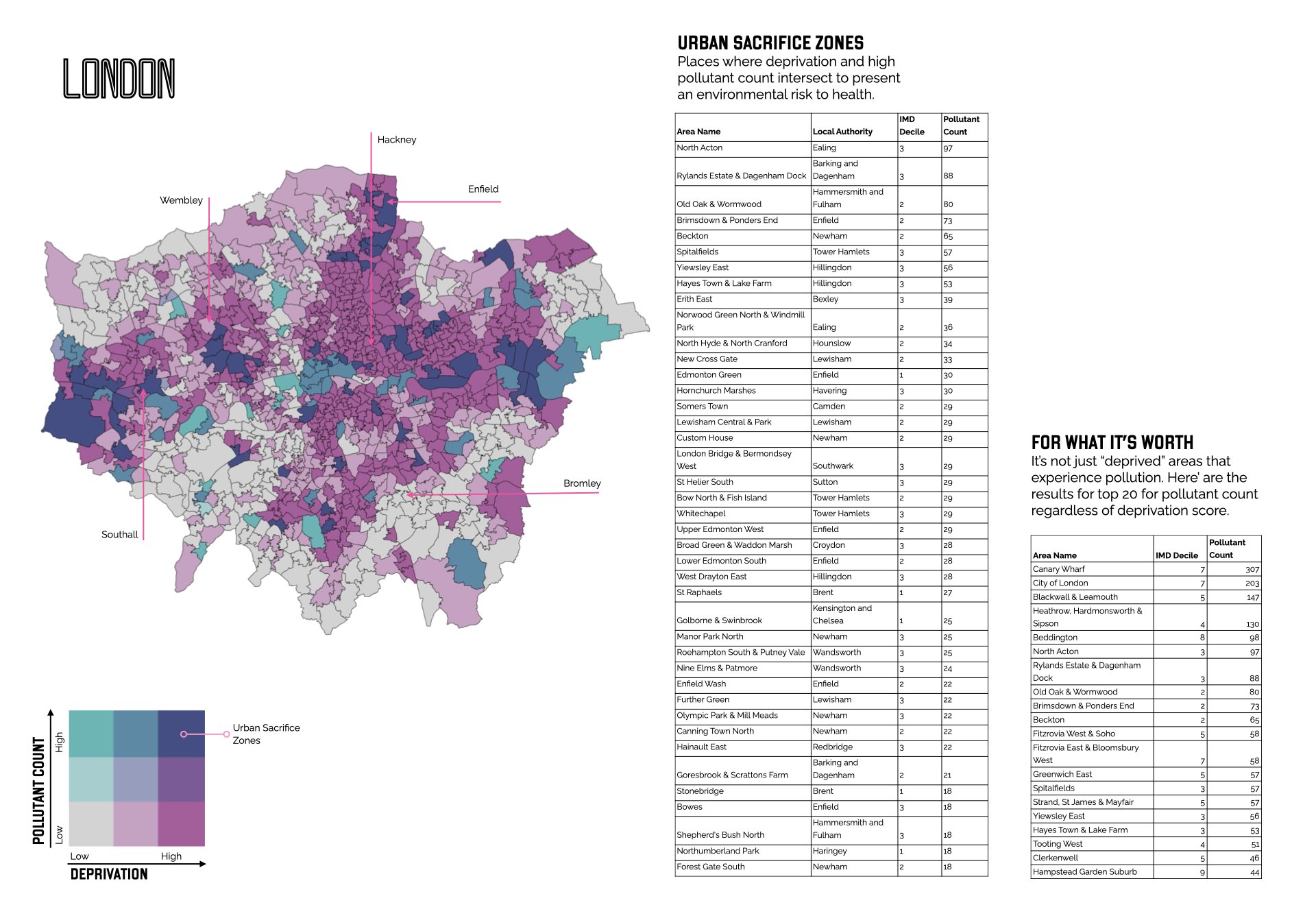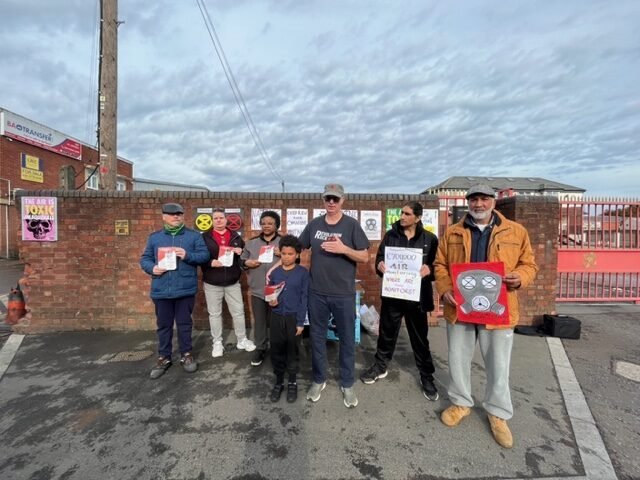Urban Sacrifice Zones & The Right to Pollute
INTRODUCTION
This data reporting sits in a long running research programme by Centric Lab to qualify pollutant based determinants of health and quantify them to geographic locations so that informed and appropriate actions can taken by the Peoples that live there.
“By comparing the two approaches we can make the argument that without a grassroots and lived experience centring environmental justice efforts are less impactful. In order for a more accurate understanding of environmental injustice in the UK greater emphasis needs to be on creating pathways for communities and those with lived experiences to lead.”
The working definition of a Sacrifice Zone is a geographic area that has been permanently impaired by environmental damage or economic disinvestment.
Such an expansive and non-specific definition of ‘sacrifice zones’ causes two problems.
Firstly, it allows for legal disputes over what is meant by “impaired” and “permanently”. These disputes often exist between what a legal firm instructed by a corporation defines as impaired or permanent and how a community abolishing injustice defines these terms based on their everyday lived experience.
Secondly, it means that policy and legality only is concerned when the bad thing is an extreme case. This leaves communities unable to seek justice at those first instances of poor health outcomes. In this report, we are proposing the use of geospatial and physiological data to create a more specific working definition of “Sacrifice Zones”, one that will allow communities to hold industrial polluters accountable at “first harm” or as close to “first harm” as possible.
The purpose of this data led study is to bring attention to everyday people those who have the right to pollute in their neighbourhoods, so that people can make more informed decisions when it comes to voting and priorities for our shared health and climate change action points.
This study exists because you don’t have the permission to drop litter but they have permission to pollute. There are no safe levels of pollutants, only an epistemology that prefers to question how much can something be pushed before it breaks down rather than how to optimise life; Nature and human.
You can use this study to understand some key trends and go to right-to-know.org to enter your postcode and find who has the right-to-pollute in your neighbourhood and locale.

DOWNLOAD REPORT

1 of 10 pages in the report that looks at the location and density of sites of pollution.
RELATED WORK
Taking on an Ecological Justice approach to the NPPF requires a foundational shift to the role and motivations around planning and the relationship with land in the UK.
The purpose of this Systems of Power board is to build confidence for community and grassroots led advocacy in health justice issues as they navigate political and governmental systems and their layers of entrenched power.
The purpose of the Environmental Data for Health Justice board is to build confidence in how those seeking structural health justice outcomes through research, campaigns, and other forms of advocacy use data as a language to directly address health injustices and develop strategies for health justice.
This project brought together people with knowledges across a variety of policy, organising in healthcare and the criminal justice system, as well as environmental and climate justice.
Tribal law scholar, Grace Carson writes in the first person about restoring the Indigenous identities and cultures to Los Angeles, where it has been systemically erased.
The pathways to poor health outcomes for Indigenous Peoples are multifaceted and interconnected. Here, we provide a brief overview of the devastating effects of colonisation, forced assimilation, displacement, and systemic oppression have on health.
The purpose of this data led study is to bring attention to everyday people those who have the right to pollute in their neighbourhoods, so that people can make more informed decisions when it comes to voting and priorities for our shared health and climate change action points.
The intention of this audio project is to discuss the links between systems and imaginations rooted in supremacy, the dysregulation of planetary systems, and the poor health outcomes being experienced by peoples who are racialised and minoritised.
What is often missing from the conversation is how environmental hazards, due to being an experience of stress and trauma can lead to mental distress.
When people can no longer use their home to heal and feel that they are in a place of rest, they are at greater risk of not restoring. The home in the case of higher costs is no longer a healer but a harmer.
Regeneration is a word used to promote positive benefit from construction and urbanisation. However, construction on old gas works sites without biologically adequate provisions are putting various communities across the UK at high risk for poor health outcomes.
This project was created to showcase the lived experience of how colonisation has affected Indigenous Peoples in varied and unique ways, ripping some of us from Ancestral Lands, Peoples, and culture whilst others are currently fighting to keep their territories as colonisation continues to evolve.
Depression is recognised as ‘a major contributor to the overall global burden of disease’ and has both a complex aetiology and symptomatology. It is often framed as a mental health problem, however, the more we understand the more we uncover its physical symptomology.
A data-led article on the toxification of Land in the UK at the hands of industrialisation whilst the general public is shamed and gaslit for their systemic need to get into a motor vehicle. All the while, millions of tonnes of chemicals are churned out into the environment.
Data does not operate in a vacuum as every part of the process is coloured by top down factors such as culture. Which data is collected, how it is analysed and the insights drawn from data are all decision points practitioners have to make and all practitioners belong to a specific culture which influences them.
This open-letter is a list of our thoughts and concerns based from attending a public meeting held between Newcastle-under-Lyme Borough Council, Public Health England, Staffordshire County Council, the Environment Agency, and the community where Walleys Quarry Landfill site is located.
This report will focus primarily on the role of the built environment because practitioners have a significant influence on the ability of citizens to build healthy relationships between health and place.
In the context of Covid-19, air pollution presents a particularly insidious hazard given that the disease affects respiratory and cardio-vascular systems.
In any given area, there will be people who are suffering greatly from the consequences of air pollution whilst others may not see any consequences. This phenomenon is worth understanding, rather than dismissing it as not statistically significant.
This paper looks to approach the inequitable prevalence of COVID-19 from a biological perspective, drawing a clear throughline between human health and urban environments. Specifically, its relation to COVID-19 in BAME communities of London.
This report is the result of a co-designed and produced community-led scientific study highlighting the susceptibility of the Southall community and the need for stricter air pollution guidelines.
PTSD is growing in urban environments and its prevalence is disproportionately higher within impoverished neighbourhoods. Our research question is: are some urban environments so inadequate they can cause physical and psychological trauma?
This paper sets out Centric Lab’s responses to questions and policy changes proposed changes to the National Planning Policy Framework on 30 July 2024. It included questions and proposed changes on a number of topics, which have implications for people’s health and wellbeing.























